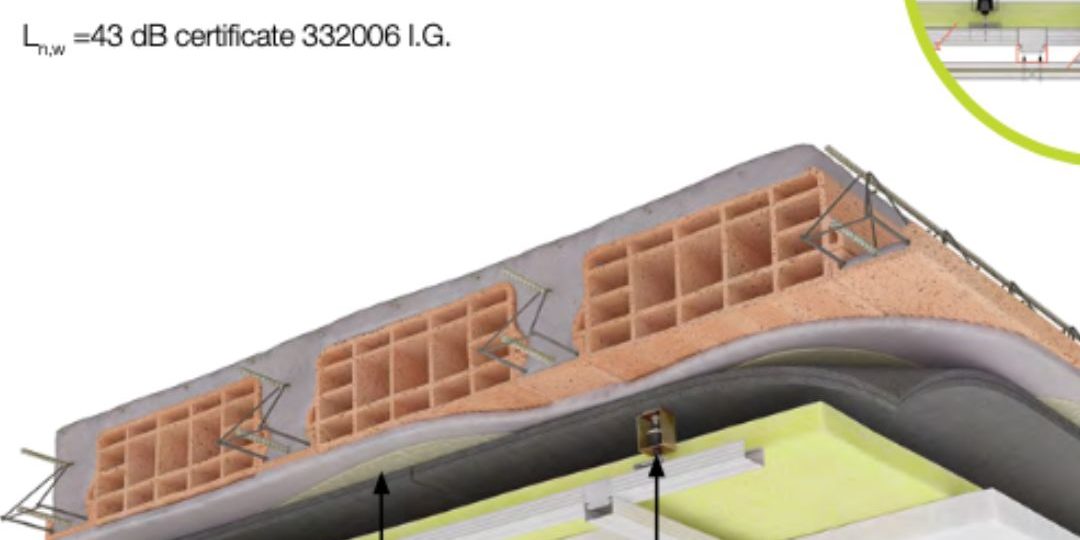In architectural acoustics and soundproofing design, two technical terms often appear in product specifications and acoustic reports — Rw and Ln,w. Though they look similar, they describe very different aspects of how sound travels through building elements. Understanding what each one means is essential for making the right decisions when designing or selecting walls, floors, or ceilings for acoustic comfort. In this article, we’ll break down the difference between Rw (Weighted Sound Reduction Index) and Ln,w (Weighted Normalized Impact Sound Pressure Level), explain how they’re measured, and show what their values tell us about real-world soundproofing performance.
🎧 Rw (Weighted Sound Reduction Index)
➤ What it measures
Rw (measured in decibels, dB) quantifies how well a building element (like a wall, door, window, or floor) reduces airborne sound transmission between two spaces.
In simple terms:
Rw tells you how much sound a wall blocks.
➤ How it’s measured
- The element is tested in a laboratory between two rooms.
- A loud broadband noise is played on one side.
- The sound levels in both rooms are measured across frequencies (typically 100–3150 Hz).
- The difference between them gives the sound reduction index (R) at each frequency.
- These values are compared to a reference curve to produce a single number — Rw.
➤ Typical interpretation
| Rw (dB) | Acoustic performance | Example |
|---|---|---|
| 25–30 | Poor | Light partition wall |
| 35–40 | Moderate | Standard apartment wall |
| 45–50 | Good | Soundproof office wall |
| 55–60+ | Excellent | Studio-grade wall or door |
➤ Use case
Rw applies to:
- Walls and partitions
- Doors and windows
- Ceilings and floors (for airborne noise)
It does not account for impact or structure-borne noise.
🔨 Ln,w (Weighted Normalized Impact Sound Pressure Level)
➤ What it measures
Ln,w (also in dB) quantifies how much impact sound passes through a floor/ceiling system, such as:
- Footsteps
- Dropped objects
- Moving furniture
In simple terms:
Ln,w tells you how much sound a floor transmits when it’s hit or walked on.
➤ How it’s measured
A standard tapping machine strikes the floor surface at fixed intervals.
The resulting sound levels in the room below are measured across frequency bands.
After normalizing for room conditions, the results are compared to a reference curve to obtain Ln,w.
Quisque id semper justo, eu scelerisque nunc. In hac habitasse platea dictumst. Nunc vel tellus id nulla scelerisque mollis. Aliquam ornare enim id nisl rhoncus porttitor. Nunc quis eros metus. Aliquam at molestie velit, quis porta velit.
Nulla diam odio, euismod nec finibus a, consectetur vitae nisi.
Curabitur et dui sed ligula pharetra gravida. Aenean nec quam sapien. Duis mauris sem, maximus non consectetur id, consequat id est. Fusce erat ligula, gravida tempus sem eget, scelerisque iaculis enim. Donec sed facilisis lacus.
Cum sociis natoque penatibus et magnis dis parturient montes, nascetur ridiculus mus. Aenean malesuada lacinia elit, non sagittis diam euismod consectetur. Nulla maximus nunc ut sem placerat efficitur ac ut urna.
➤ Typical interpretation
| Ln,w (dB) | Acoustic performance | Example |
|---|---|---|
| 80–90 | Poor | Bare concrete slab |
| 65–75 | Moderate | Carpeted residential floor |
| 50–60 | Good | Floating floor with insulation |
| < 45 | Excellent | High-end acoustic floating floor |
💡 Lower Ln,w values = better performance
Higher Rw values = better performance
🏗️ Example
Imagine a floor-ceiling assembly between two apartments:
- Rw = 55 dB → airborne noise (like TV or conversation) is well blocked.
- Ln,w = 60 dB → impact noise (like footsteps) is still moderately audible below.
Adding a floating floor or resilient underlay can improve Ln,w (reduce it to, say, 45 dB) — without necessarily changing Rw much.


